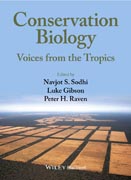
Conservation Biology: Voices from the Tropics
Sodhi, Navjot S.
Gibson, Luke
Raven, Peter H.
The late Navjot Sodhi conceived this book as a way of bringing to the forefront of our conservation planning for the tropics the views of people who were actually working and living there. In its 31 chapters, 55 authors present their views on the conservation problems they face and how they deal with them. Effective long term conservation in the tropics requires the full participation of local people, organizations and governments. The human population of tropical countries is expected to grow by more than 2.5 billion people over the next several decades, with expectations of increased consumption levels growing even more rapidly than population levels; clearly there will be a need for more trained conservationists and biologists. Significant levels of local involvement are essential to conservation success, with the rights of local people fully recognized, protected and fostered by governmental and international assistance. Overarching conservation plans are necessary, but cannot in themselves lead to success. The individual experiences presented in the pages of this book will provide useful models that may serve to build better and more sustainable lives for the people who live in the tropics and lead to the continued survival of as many species and functioning ecosystems as possible. INDICE: List of Contributors vii Notes on Contributors xi Acknowledgments xx Remembering Navjot Sodhi: An Inspiring Mentor, Scholar, and Friend xxi Maharaj K. Pandit 1 INTRODUCTION: GIVING A VOICE TO THE TROPICS, 1 Luke Gibson and Peter H. Raven PART 1: FROM WITHIN THE REGION, 5 SECTION 1: AFRICA, 5 2 CONSERVATION PARADIGMS SEEN THROUGH THE EYES OF BONOBOS IN THE DEMOCRATIC REPUBLIC OF CONGO, 7 Bila–Isia Inogwabini and Nigel Leader–Williams 3 GOVERNANCE FOR EFFECTIVE AND EFFICIENT CONSERVATION IN ETHIOPIA, 19 Fikirte Gebresenbet, Wondmagegne Daniel, Amleset Haile and Hans Bauer 4 WILDLIFE IN JEOPARDY INSIDE AND OUTSIDE PROTECTED AREAS IN CÔTE D’IVOIRE: THE COMBINED EFFECTS OF DISORGANIZATION, LACK OF AWARENESS, AND INSTITUTIONAL WEAKNESS, 26 Inza Koné 5 CONSERVATION CHALLENGES FOR MADAGASCAR IN THE NEXT DECADE, 33 Hajanirina Rakotomanana, Richard K.B. Jenkins and Jonah Ratsimbazafy 6 CONSERVATION IN MAURITIUS AND RODRIGUES: CHALLENGES AND ACHIEVEMENTS FROM TWO ECOLOGICALLY DEVASTATED OCEANIC ISLANDS, 40 F.B. Vincent Florens 7 DESIGN AND OUTCOMES OF COMMUNITY FOREST CONSERVATION INITIATIVES IN CROSS RIVER STATE OF NIGERIA: A FOUNDATION FOR REDD+?, 51 Sylvanus Abua, Robert Spencer and Dimitrina Spencer 8 SHADES OF GREEN: CONSERVATION IN THE DEVELOPING ENVIRONMENT OF TANZANIA, 59 Flora I. Tibazarwa and Roy E. Gereau 9 SUSTAINABLE CONSERVATION: TIME FOR AFRICA TO RETHINK THE FOUNDATION, 65 Mwangi Githiru SECTION 2: AMERICAS, 75 10 CHALLENGES AND OPPORTUNITIES FOR BRIDGING THE RESEARCH–IMPLEMENTATION GAP IN ECOLOGICAL SCIENCE AND MANAGEMENT IN BRAZIL, 77 Renata Pardini, Pedro L.B. da Rocha, Charbel El–Hani and Flavia Pardini 11 CONSERVING BIODIVERSITY IN A COMPLEX BIOLOGICAL AND SOCIAL SETTING: THE CASE OF COLOMBIA, 86 Carolina Murcia, Gustavo H. Kattan, and Germán Ignacio Andrade–Pérez 12 INDIGENOUS RIGHTS, CONSERVATION, AND CLIMATE CHANGE STRATEGIES IN GUYANA, 97 Michelle Kalamandeen 13 CHALLENGES AND OPPORTUNITIES FOR CONSERVATION OF MEXICAN BIODIVERSITY, 105 Gerardo Ceballos and Andrés García 14 PARAGUAY’S CHALLENGE OF CONSERVING NATURAL HABITATS AND BIODIVERSITY WITH GLOBAL MARKETS DEMANDING FOR PRODUCTS, 113 Alberto Yanosky SECTION 3: ASIA, 121 15 LAND–USE CHANGE AND CONSERVATION CHALLENGES IN THE INDIAN HIMALAYA: PAST, PRESENT, AND FUTURE, 123 Maharaj K. Pandit and Virendra Kumar 16 CONSERVATION CHALLENGES IN INDONESIA, 134 Dewi M. Prawiradilaga and Herwasono Soedjito 17 SINGAPORE: HALF FULL OR HALF EMPTY?, 142 Richard T. Corlett 18 WANT TO AVERT EXTINCTIONS IN SRI LANKA? EMPOWER THE CITIZENRY!, 148 Rohan Pethiyagoda 19 CONSERVATION OF HORNBILLS IN THAILAND, 157 Pilai Poonswad, Vijak Chimchome, Narong Mahannop and Sittichai Mudsri SECTION 4: OCEANIA, 167 20 TIPPING POINTS AND THE VULNERABILITY OF AUSTRALIA’S TROPICAL ECOSYSTEMS, 169 William F. Laurance 21 BIODIVERSITY AND CONSERVATION IN THE PACIFIC ISLANDS: WHY ARE WE NOT SUCCEEDING?, 181 Gilianne Brodie, Patrick Pikacha and Marika Tuiwawa 22 WHEN WORLDS COLLIDE: CHALLENGES AND OPPORTUNITIES FOR CONSERVATION OF BIODIVERSITY IN THE HAWAIIAN ISLANDS, 188 Carter T. Atkinson, Thane K. Pratt, Paul C. Banko, James D. Jacobi and Bethany L. Woodworth 23 THE CHIMERA OF CONSERVATION IN PAPUA NEW GUINEA AND THE CHALLENGE OF CHANGING TRAJECTORIES, 197 Phil Shearman PART 2 THOUGHTS FROM DIASPORA, 205 24 COMPLEX FORCES AFFECT CHINA’S BIODIVERSITY, 207 Jianguo Liu 25 GOVERNANCE AND CONSERVATION IN THE TROPICAL DEVELOPING WORLD, 216 Kelvin S.–H. Peh 26 KNOWLEDGE, INSTITUTIONS, AND HUMAN RESOURCES FOR CONSERVATION OF BIODIVERSITY, 226 Kamaljit S. Bawa 27 PEOPLE, PLANTS AND POLLINATORS: UNITING CONSERVATION, FOOD SECURITY, AND SUSTAINABLE AGRICULTURE IN EAST AFRICA, 232 Dino J. Martins 28 BALANCING SOCIETIES’ PRIORITIES: A SCIENCE–BASED APPROACH TO SUSTAINABLE DEVELOPMENT IN THE TROPICS, 239 Lian Pin Koh 29 BIODIVERSITY CONSERVATION PERFORMANCE OF SUSTAINABLE–USE TROPICAL FOREST RESERVES, 245 Carlos A. Peres 30 CONCLUDING REMARKS: LESSONS FROM THE TROPICS, 254 Luke Gibson and Peter H. Raven Index 259
- ISBN: 978-0-470-65863-5
- Editorial: Wiley–Blackwell
- Encuadernacion: Cartoné
- Páginas: 288
- Fecha Publicación: 10/09/2013
- Nº Volúmenes: 1
- Idioma: Inglés
